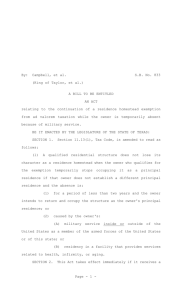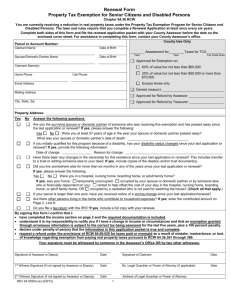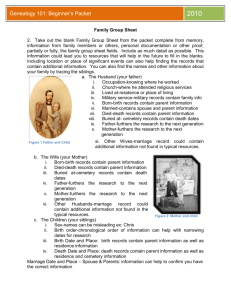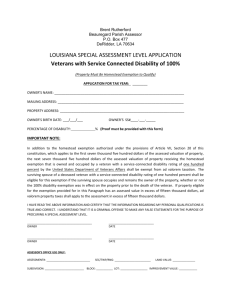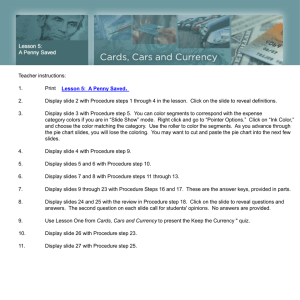Senior/Disabled Persons Exemption Application
advertisement
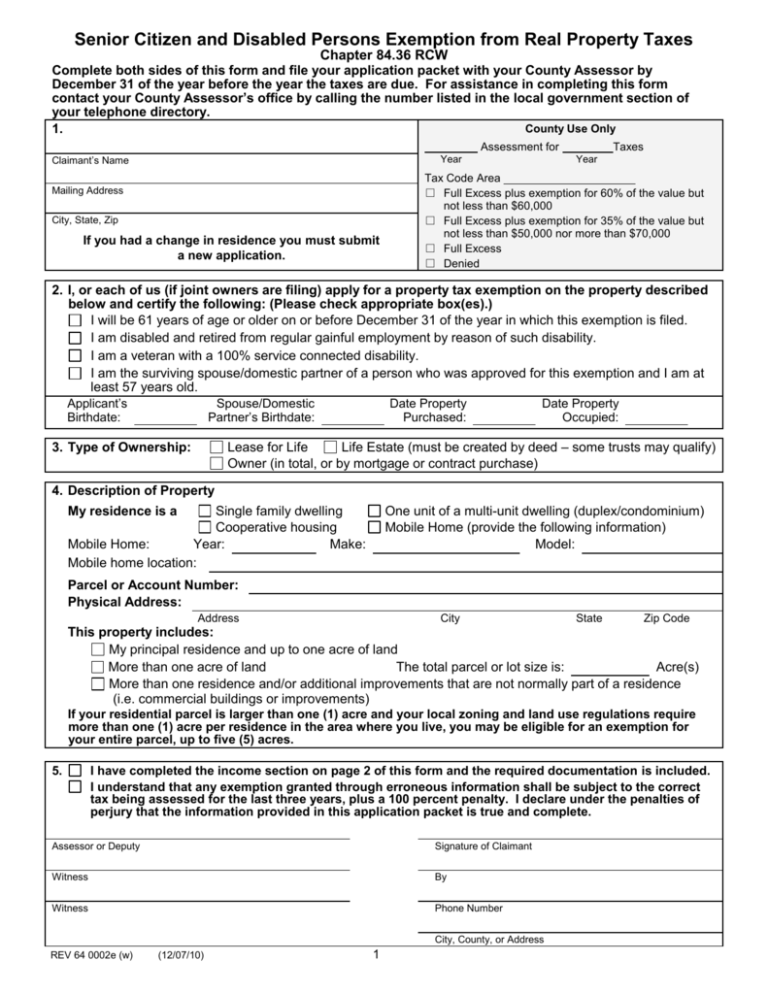
Senior Citizen and Disabled Persons Exemption from Real Property Taxes Chapter 84.36 RCW Complete both sides of this form and file your application packet with your County Assessor by December 31 of the year before the year the taxes are due. For assistance in completing this form contact your County Assessor’s office by calling the number listed in the local government section of your telephone directory. County Use Only 1. Assessment for Claimant’s Name Year Mailing Address City, State, Zip If you had a change in residence you must submit a new application. Taxes Year Tax Code Area □ Full Excess plus exemption for 60% of the value but not less than $60,000 □ Full Excess plus exemption for 35% of the value but not less than $50,000 nor more than $70,000 □ Full Excess □ Denied 2. I, or each of us (if joint owners are filing) apply for a property tax exemption on the property described below and certify the following: (Please check appropriate box(es).) I will be 61 years of age or older on or before December 31 of the year in which this exemption is filed. I am disabled and retired from regular gainful employment by reason of such disability. I am a veteran with a 100% service connected disability. I am the surviving spouse/domestic partner of a person who was approved for this exemption and I am at least 57 years old. Applicant’s Birthdate: Spouse/Domestic Partner’s Birthdate: Date Property Purchased: Date Property Occupied: Lease for Life Life Estate (must be created by deed – some trusts may qualify) Owner (in total, or by mortgage or contract purchase) 3. Type of Ownership: 4. Description of Property My residence is a Single family dwelling Cooperative housing Mobile Home: Year: Make: Mobile home location: One unit of a multi-unit dwelling (duplex/condominium) Mobile Home (provide the following information) Model: Parcel or Account Number: Physical Address: Address City State Zip Code This property includes: My principal residence and up to one acre of land More than one acre of land The total parcel or lot size is: Acre(s) More than one residence and/or additional improvements that are not normally part of a residence (i.e. commercial buildings or improvements) If your residential parcel is larger than one (1) acre and your local zoning and land use regulations require more than one (1) acre per residence in the area where you live, you may be eligible for an exemption for your entire parcel, up to five (5) acres. 5. I have completed the income section on page 2 of this form and the required documentation is included. I understand that any exemption granted through erroneous information shall be subject to the correct tax being assessed for the last three years, plus a 100 percent penalty. I declare under the penalties of perjury that the information provided in this application packet is true and complete. Assessor or Deputy Signature of Claimant Witness By Witness Phone Number City, County, or Address REV 64 0002e (w) (12/07/10) 1 Combined Disposable Income Worksheet As defined in RCW 84.36.383 (4) and (5) and WAC 458-16A-100 (6) and (12) Income: 20 County Use Income Year Checklist $ Amount IRS Tax Return A. Enter your Adjusted Gross Income (AGI) from your Federal Tax Return. If you did not file an income tax return with IRS, enter -0- here and report your income from all sources on the appropriate lines below. 1040 1040-A 1040-EZ B. Add Capital Gains not already included in Line A. Do not add the gain from the sale of a primary residence if you used the gain to purchase a replacement residence within the same year. Do not use losses to offset gains. (Ex: On your Sch D, you have a short term capital gain of $10,000 and a long-term capital loss of ($13,000). Add the $10,000 gain that was offset by the loss.) C. Deductions for Losses. If your AGI includes deductions for losses, the losses must be added back. Add back any losses shown in the “Income Section” of your federal return, including losses from business ventures and rentals as well as capital losses. (Ex: On Line 13 of your 1040 you reported a ($3,000) loss. Add back the ($3,000) loss included in your AGI.) D. Deductions for Depreciation. Deductions for depreciation must be added back to the extent those deductions reduced your AGI. (Net loss reported: If you deducted depreciation as a business and/or rental expense that resulted in a loss, recalculate the net income/loss without the depreciation expense. If there is still a net loss enter -0- here, if there is net income enter the net income here.) E. Dividends or interest not already included in the amount on Line A. Include non- Bank Statement taxable interest on state and municipal bonds. F. Pensions and annuities. Report non-taxable pension and annuity amounts not included in the amount on Line A, but do not include non-taxable IRA distributions. G. Military Pay and Benefits. Report non-taxable military pay and benefits not included in DFAS Statement the amount on Line A. Do not include attendant-care and medical-aid payments. Report your CRSC here. H. Veterans Pay and Benefits. Report non-taxable veterans’ pay and benefits not included VA Statement in the amount on Line A. Do not include attendant-care and medical-aid payments. For the 2008 income year and forward, do not include disability compensation or dependency and indemnity compensation you receive from the Department of Veterans Affairs. I. Social Security and Railroad Retirement Benefits. Report non-taxable Social Security and Railroad Retirement not already included in the amount on Line A. (Ex: If your gross Social Security benefit was $10,000 and $4,000 was included in AGI as the taxable amount, report the non-taxable $6,000 here.) SS Statement RRB Statement J. Income from Schedules C, E, and F not already included in the amount on Line A. You can deduct normal expenses except depreciation expense, but do not use losses to offset income. (Ex: You filed two Sch C’s – one with a ($10,000) loss and one with a $5,000 net income. A net loss of ($5,000) was reported on your 1040, Line 12. Use this line to add the $5,000 net income that was offset by the loss.) K. Other Income not already included in the amount on Line A. Give source, type, Other_________ and amount. Subtotal Income: $ 0.00 Less Non-Reimbursed Allowable Deductions: L. M. N. O. Nursing Home, Boarding Home, or Adult Family Home Expenses. In-Home Care Expenses. See instructions for expenses that may qualify. Prescription Drug Costs. Report out-of-pocket costs. Insurance Premiums paid for Medicare under Titled XVIII of the Social Security Act (Parts A, B, C, and D). Do not include supplemental or long-term care insurance premiums. P. Enter -0- here if you filed a return with IRS and entered an amount on Line A. If you did not file a return with IRS and you had deductions to gross income normally allowed by IRS, enter those deductions here. Allowable adjustments include alimony you paid, tuition, moving expenses, and others. See the instructions. Subtotal Allowable Deductions: $ 0.00 Total Combined Disposable Income: $ 0.00 County Use Only: REV 64 0002e (w) (12/07/10) 2 Printout/Receipts SS Statement Other_________ Instructions for Completing the Income Section How is disposable income calculated? “Disposable income” was given a specific definition by the Legislature in RCW 84.36.383(5). It is defined as adjusted gross income, as defined in the federal internal revenue code, plus all of the following that were not included in, or were deducted from, adjusted gross income: Capital gains, other than a gain on the sale of a principal residence that is reinvested in a new principal residence; Amounts deducted for losses or depreciation; Pensions and annuities, including federal Social Security Act and railroad retirement benefits; Military pay and benefits other than attendant-care and medical-aid payments; Veterans pay and benefits other than attendant-care payments and medical-aid payments; veterans disability benefits and dependency and indemnity compensation; and Dividend receipts and interest received on state and municipal bonds. These income sources are included in disposable income whether or not they are taxable for IRS purposes. Include all income sources and amounts for you, your spouse/domestic partner, and any co-tenants that you received during the application/assessment year. The application/assessment year is the year before the taxes are actually due. Special instructions for Lines G and H. In 2008, the Legislature passed SSB5256 which allows you to exclude veterans’ disability benefits and dependency and indemnity compensation as defined in Title 38, part 3, sections 3.4 and 3.5 of the code of federal regulations. If you are receiving these benefits, you no longer have to include those amounts in your disposable income. You must still include other military and veterans’ benefits other than attendant-care and medical-aid payments. CRSC benefits must still be included in disposable income. Special instructions for Line P. If you had adjustments to your income for any of the following and you did not file an IRS return, report the amounts on Line P and include the IRS form or worksheet you used to calculate the amount of the adjustment. Certain business expenses for teachers, reservists, performing artists, and fee-basis government officials Self-employed health insurance or contributions to pension, profit-sharing, or annuity plans Health savings account deductions Moving expenses IRA deduction Alimony paid Student loan interest, tuition, and fees deduction Domestic products activities deduction REV 64 0002e (w) (12/07/10) What if my income changed in mid-year? If your income was substantially reduced (or increased) for at least two months before the end of the year and the change in income is expected to continue indefinitely, you can use your new average monthly income to estimate your annual income. Calculate your income by multiplying your new average monthly income (during the months after the change occurred) by twelve. Example: You retired in September and your monthly income was reduced from $2,000 to $1,000 beginning in October. Multiply $1,000 x 12 to estimate your new annual income. Provide documentation that shows your new monthly income and when the change occurred. What is combined disposable income? Combined disposable income is defined in RCW 84.36.383(4) as your disposable income plus the disposable income of your spouse or domestic partner and any co-tenants, minus amounts paid by you or your spouse or domestic partner for: Prescription drugs; Treatment or care for you or your spouse/domestic partner, received in the home (Care or treatment in your home means medical treatment or care received in the home. You can deduct costs for items such as oxygen, special needs furniture, attendant-care, light housekeeping tasks, meals-on-wheels, life alert, and other services that are part of a necessary or appropriate in-home service.); Treatment or care for you or your spouse/domestic partner in a nursing home, boarding home, or adult family home; and Health care insurance premiums for Medicare. (At this time, other types of insurance premiums are not an allowable deduction.) Report these costs on Lines L through O. What are the program benefits? If you meet the qualifications, the taxable value of your home will be “frozen” as of January 1 in the year you first qualify for this program. Even though your assessed value may increase, your taxable value will remain constant. In addition, your combined disposable income determines your level of reduction (exemption) in your annual property taxes. Levels of Reduction Income 0 - $25,000 Exempt from regular property taxes on $60,000 or 60% of the valuation, whichever is greater, plus exemption from 100% of excess levies. $25,001 - $30,000 Exempt from regular property taxes on $50,000 or 35% of the valuation, whichever is greater, not to exceed $70,000, plus exemption from 100% of excess levies. $30,001 - $35,000 Exempt from 100% of excess levies. Please contact your county assessor’s office for assistance in completing this form. 3 Documentation to Include You must provide documentation to the Assessor for all income received by you, your spouse or domestic partner, and any cotenants. Other types of payments may be found listed in the IRS Publication “Instructions for Forms 1099, 1098, 5498, and W-2G”. Federal Tax Forms To the extent your return includes any of the following forms or schedules, a copy must be included with your application. Other Income Sources If you have income from other sources and you did not receive a W2 or 1099 for the income you received, provide the following: a statement from the organization that issued the payments (DSHS, WA Labor & Industries, U.S. Dept. of Labor (OWCP), etc.); copies of your monthly bank statements with a statement describing the type of income received (e.g. workers’ compensation, state cash and food assistance, tips, cash earned from yard sales or odd jobs, rental income, groceries purchased for you in return for a room in your house, etc.). IRS Form 1040 IRS Form 1040A IRS Form 1040EZ Schedule B - Interest & Ordinary Dividends Schedule C - Profit & Loss from Business (Sole Proprietorship) Schedule D - Capital Gains & Losses Schedule E - Supplemental Income & Loss Schedule F - Profit & Loss from Farming Form 4797 - Sales of Business Property Form 6252 - Installment Sale Income Form 8829 - Expenses for Business Use of your Home Social Security Statement (Generally, SSA 1099) PROOF OF EXPENSES Provide documentation for all allowable out-ofpocket expenses that were not reimbursed by insurance or a government program. Provide a copy of an invoice, bill, or cancelled check if you or your spouse or domestic partner paid for any of the following: Care in a nursing home, boarding home, or adult family home In-home care Prescription drugs (Most pharmacies will provide a print-out for the year if you ask for one.) Medicare prescription drug or Medicare Advantage insurance plans Non-IRS Filers: For applicants who do not file an IRS return, you must provide documentation of all income that would have been reported on a federal return by you, your spouse/domestic partner, and any co-tenants. Other Documents: Include standard federal forms and documents used by others to report income they paid out, including but not limited to, the following: 1. W-2’s - Wage & Tax Statement W-2-G - Certain Gambling Winnings 2. 1099’s: 1099-B - Proceeds from Broker & Barter Exchange 1099-Div - Dividends & Distributions 1099-G – Unemployment Compensations, State & Local Income Tax Refunds, Agricultural Payments 1099-Int - Interest Income 1099-Misc - Contract Income, Rent & Royalty Payments, Prizes 1099-R - Distributions from Pensions, Annuities, IRA’s, Insurance Contracts, Profit Sharing Plans 1099-S - Proceeds from Real Estate Transactions RRB-1099 - Railroad Retirement Benefits SSA-1099 - Social Security Benefits REV 64 0002e (w) (12/07/10) PROOF OF AGE OR DISABILITY AND PROOF OF OWNERSHIP AND RESIDENCY You must provide documentation to the Assessor demonstrating you meet the age or disability, ownership, and residency requirements. 4 A copy of your photo ID and/or birth certificate. If your eligibility is based on a disability, a copy of your disability award letter from SSA or VA, or a Proof of Disability statement completed and submitted by your physician. A complete copy of your trust documents, if applicable. A copy of your driver’s license and/or voter registration.

